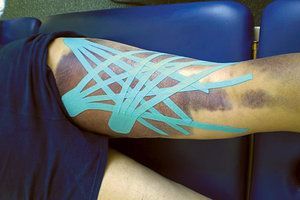If you have followed beach volleyball at all in the past 5 years you would know that Kerri Walsh Jennings helped pioneer the craze over kinesiology tape. The combination of high skin exposure, bright colors, and exotic taping patterns, was all it took to make people stop, stare, and ask "What the hell is that?" But even 5 years later people still ask me what it is that I have on my knees and if it is the same stuff they saw in the Olympics in the past. 5 years later and people are still unaware what kinesio tape is and more importantly how it works.
To summarize, kinesio tape does 3 simple things
1. Improves blood circulation
2. Improves lymphatic drainage
3. Helps correct joint alignment
If you are researching kinesio tape, then any results that you find before 2012 will in large tell you the same thing: Despite testimonial acclaim there is little evidence to support claims that the many brands of kinesio tape make in relation to their effectiveness to injury prevention, and pain alleviation.
I believe that to be the case because there has not been much research into the "why" and "how", but rather studies have mainly investigated the "what", as in "what does it do, does the quantitative data support the claims?" If the results can be easily replicated and confirmed then we (the scientific community) can give our sanctimonious seal of approval. But such is the scientific method. You love it for its diligence and scrutinize it for its tedious pace and ambiguity, much like our good friend Hank explains here.
It may be one thing to discredit kinesio tape with the placebo effect, but there isn't a placebo effect for range of motion or swelling. Clearly something is going on, but we still aren't quite sure why. We have some general explanations which say that the tension in the tape helps lift the skin and tissue off the skeletal muscles providing just enough space to allow for better blood and lymph circulation.
That's about as much as I've found in relation to #1 and #2 in the aforementioned list above. As far as #3 is concerned, I haven't been able to find many independent reviews, criticism, or explanations. If I were to guess, it would stem from overactive or over used muscles that "pull" you out of alignment, but that is just my non-professional, non-medical explanation.
Now that I have you all caught up I can now to get to the heart of what I really want to talk about: Edema. Just recently a whole new perspective have been taken toward edema, as known as swelling, virtually wiping out the past 40 years of convention. No longer are ice baths going to be the mandate, and as our knowledge and technology improve we will likely look back at generic white athletic tape, like we do at tough football coaches that told struggling players to "rub some dirt on it, and get back out there": a crass treatment to a maddeningly complicated piece of biological tissue and fluid.
It wasn't that long ago that I stumbled upon these even more bizarre taping applications specifically for edema, but unlike their close relative for common injuries, where you can find DIY applications on YouTube, these applications are much more intricate and should be done by a professional. So to ask your initial question, no those elaborate designs are not just for show.
So even if the claims may seem largely unfounded and built on theory, rather than experimental data, at the end of the day you still have thousands of athletes, spanning all sports that swear by it, that have used it on virtually every part of their body, and placebo effect or not, comfort during the heat of competition is something that isn't highly valued until you don't have it. Just ask Derrick Rose. I'm always looking for ways to improve as a player and become better and that includes all facets and cultures that help me sustain my high level of play. KT Tape (my preferred brand) hasn't let me down yet, and their newly improved and simplified applications make adhesion and effectiveness far superior than when I first bought a roll a little more than a year ago. So while the rest of the sports world sticks to RICE as the best prescription for injuries, I think we will be forced to force two more letters into that acronym.

I had no idea that Sports Tape Australia could be so useful in preventing injuries! My son does sports all through the year, but he has gotten injured a couple times in the past. I think it would be really good for us to get him some of this sports tape so that he wouldn't be in pain when he runs.
ReplyDeleteUseful information shared. I am very happy to read this article. Thanks for giving us nice info. Fantastic walk through. I appreciate this post.Sports Tape
ReplyDeleteI think that thanks for the valuabe information and insights you have so provided here. dolor de espalda media en houston
ReplyDelete